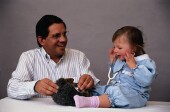- Skip Storing This Everyday Product in the Fridge Door
- Green Tea + B3 Pairing May Boost Brain Health
- Navigating Your Midlife Crisis: Embracing New Possibilities
- City Raccoons Showing Signs of Domestication
- Mapping the Exposome: Science Broadens Focus to Environmental Disease Triggers
- One Week Less on Social Media Linked to Better Mental Health
- Your Brain Changes in Stages as You Age, Study Finds
- Some Suicide Victims Show No Typical Warning Signs, Study Finds
- ByHeart Formula Faces Lawsuits After Babies Sickened With Botulism
- Switch to Vegan Diet Could Cut Your Greenhouse Gas Emissions in Half
Change in Gut Bacteria May Precede Type 1 Diabetes in Kids


In some young children who develop type 1 diabetes, a change in normal stomach bacteria can precede the disease by a year, a small study has found.
The findings, published Feb. 5 in the journal Cell, Host & Microbe, are based on just 33 children at increased genetic risk of type 1 diabetes. And experts stressed that it’s too early to tell what it all could mean.
But one hope is that the results will lead to an early diagnostic test for type 1 diabetes, said researcher Aleksandar Kostic, a postdoctoral fellow at the Broad Institute of MIT and Harvard.
There is also the possibility of developing new therapies for type 1 that would target the “ecosystem” of the gut, he said.
But that would be a long way off, Kostic stressed. “These findings open up a promising new avenue for more research,” he said. “But that’s all we can say for now.”
Type 1 diabetes differs from the much more common type 2 diabetes, which is often linked to older age and obesity. In type 1, the immune system mistakenly kills off pancreatic cells that make the blood-sugar-regulating hormone insulin. To survive, people with type 1 have to take frequent injections of insulin, or use an insulin pump, for the rest of their lives.
As many as 3 million Americans have type 1 diabetes, according to the JDRF (formerly Juvenile Diabetes Research Foundation), a New York-based organization that funds research into the disease. Often, the disease arises in childhood, but there are adult-onset cases, too.
Scientists do not know exactly what causes the abnormal immune reaction. But people who carry certain gene variants related to immune system function have a higher-than-normal risk of developing type 1 diabetes.
The new study followed 33 babies from Finland and Estonia who carried some of those gene variants. Kostic and his colleagues analyzed stool samples from the children to chart changes in the trillions of bacteria, viruses and other microorganisms that dwell in the gut — what scientists call the “microbiome.”
By age 3 years, four children had developed type 1 diabetes. And those children showed a clear change in gut “bugs” about one year before the onset of the disease.
“What we saw were huge alterations,” Kostic said. “That included a drop in the overall diversity of the ‘community.'”
He likened the situation to a rain forest that is being cleared. The decline in its natural diversity opens the door for some “bad players” to take root.
In this case, children who went on to develop diabetes showed a decline in “good bugs” that produce beneficial fatty acids, and an increase in organisms linked to inflammation, Kostic explained.
But it’s not clear, he said, whether that shift in the gut helps cause the abnormal immune reaction behind type 1 diabetes or results from it. That’s a question for future research, Kostic said.
Another expert agreed. A big next step will be to understand the physiological “pathways” that the gut microorganisms affect, said Jessica Dunne, director of discovery research for JDRF, which funded the study.
“We’re still a long way off from a therapy,” Dunne said. But, she added, researchers are already interested in whether a “probiotic” therapy might help prevent or delay type 1 diabetes in children at increased risk. Probiotics are live bacteria like those found naturally in the human body.
Another question, Kostic said, is whether these findings in toddlers would be true of older children or adults who develop type 1 diabetes. He said it’s fairly uncommon for the disease to be diagnosed by age 3, and it’s possible there’s something “unique” about children who develop it that early.
Dunne agreed that the disease process could be different in other age groups.
If a change in gut bacteria is a sign of diabetes to come, that could offer a way to catch the disease process early, Kostic and Dunne said.
However, only a small minority of kids who carry susceptibility genes actually develop type 1 diabetes, Kostic noted. “So genetics doesn’t tell you much,” he said.
Dunne said researchers would like to develop some way to predict which kids seem to be “on the path” to type 1 diabetes. That will be needed if any therapies to prevent or delay the disease become available.
More information
The JDRF has more on type 1 diabetes.
Source: HealthDay
Copyright © 2025 HealthDay. All rights reserved.










